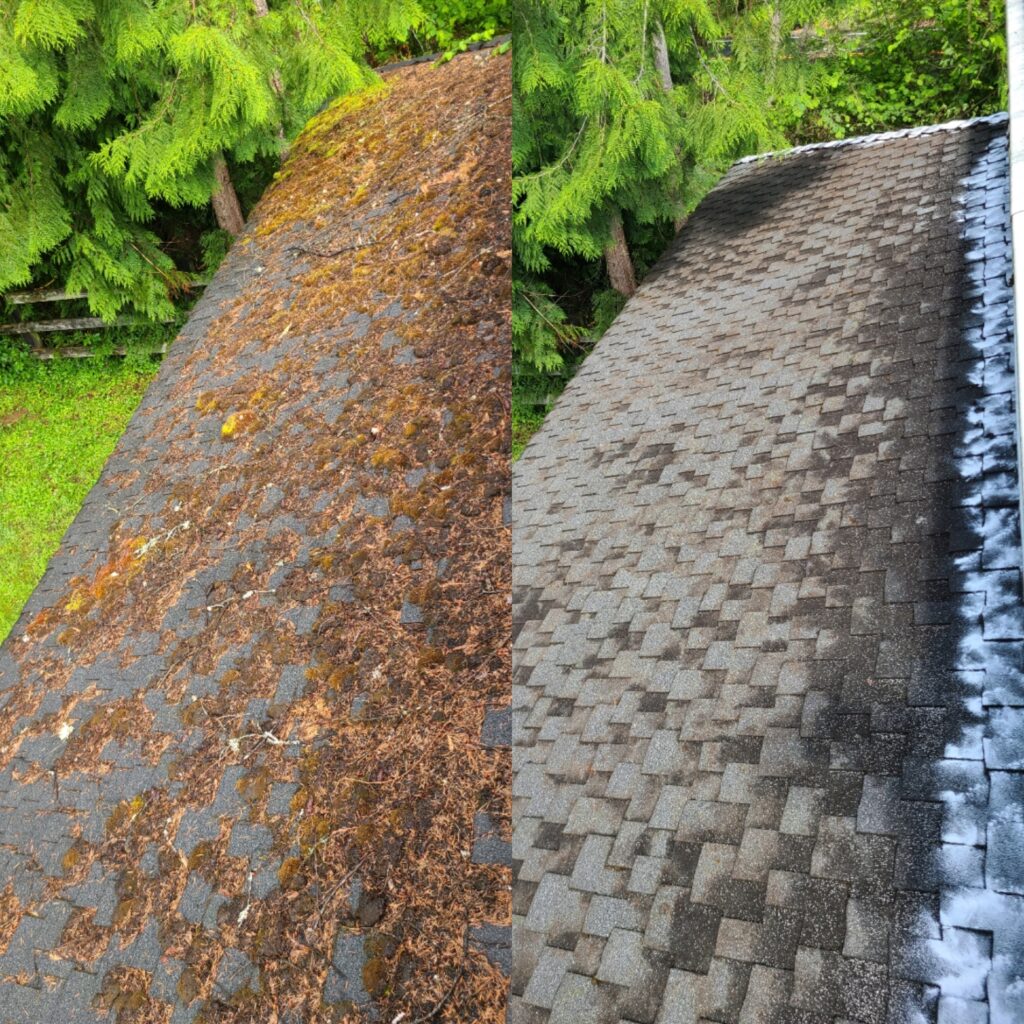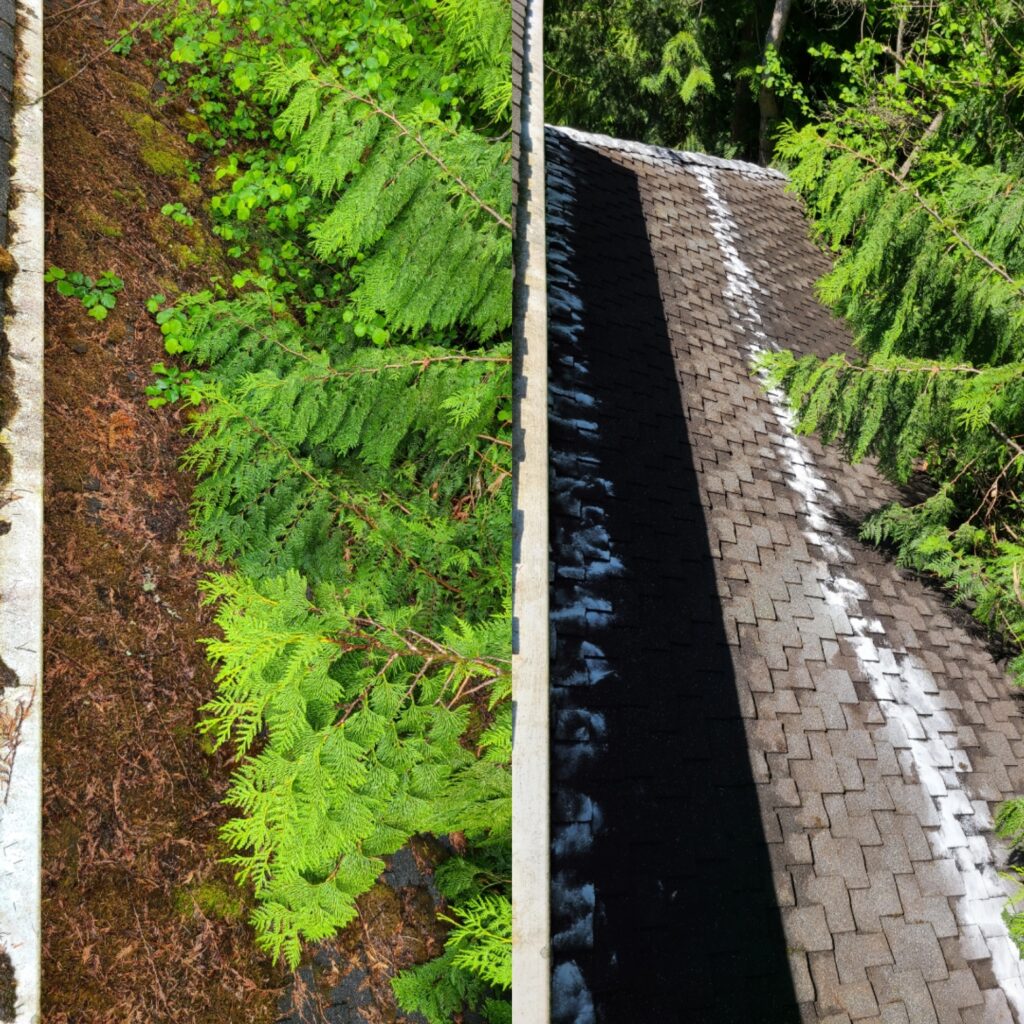Here in Western Washington, the main focuses of roof maintenance are to clear debris and remove all roof moss, algae, and mold. Keeping the roof clear protects it from the most common causes of roof leaks: moisture buildup. However, cleaning alone will not keep your roof intact forever. Follow these roof maintenance tips to keep your roof in top shape for decades to come.
The below pictures were taken about a month ago at one of our current properties. This is a newer 50-year roof installed only 6 years ago, but clearly was not being maintained. This property is tucked away amidst high-trees and is surrounded by a large natural pond a wetlands. We had of of our amazing professional partners, Legacy Gutter Cleaning LLC, come out to clean the roof and gutters… can you see a difference? They successfully cleaned off INCHES of caked on moss and debris, followed by a soft-wash of the gutters and a sprinkling of moss-away. As you can see, they also trimmed back a number of overgrown tree branches and sticker bushes from the roofline for us so that upkeep in the future would be more sustainable and the shingles would be better protected.


General Roof Maintenance Tips
- Clean your roof and gutters at least twice per year. How often your roof needs cleaning depends on how quickly debris builds up. The more additional maintenance tips you use, the less often your roof needs to be cleaned.
- Trim overhanging trees. Houses that are taller than the surrounding trees rarely accumulate debris. However, with the tall evergreen trees of the Pacific Northwest, you may consider paring back on the foliage near your house.
- Use gutter guards. Your gutters will be much cleaner if the debris never reaches them in the first place. Gutter guards create a barrier that blocks leaves, pine needles, and debris but lets water through. They aren’t perfect and your gutters will still need occasional cleaning, but they take care of the bulk of the work.
- Check your attic for roof problems. Soft spots which are difficult to find on the roof may be much easier to find from your attic. On a sunny day, someone in the attic can look for light patches in the ceiling. Wherever the light coming in is irregular, that section of the roof should be inspected for damage.
- Watch how water drains. On a rainy day, especially a day with heavy rainfall, check your gutters. See if water is collecting anywhere instead of moving away from the house. Water buildup on the roof leads to leaks while water buildup on the ground can lead to structural damage. However, it may not be safe to check the roof for water buildup during rainfall. Checking the roof for damp or soft spots the day after heavy rainfall is generally safer.
- Fix leaks right away. It’s tempting to toss a towel or bucket under a roof leak and get to it when you have time, but it pays to be prompt. In most cases, there is more water damage taking place than you can see. There may be a small circle on the ceiling or tiny drip lines on the wall, but water may be leaking inside the walls where you can’t see it.
- Have your roof maintenanced professionally. Even if you clean your roof and gutters regularly on your own, it never hurts to have a professional roof inspection and cleaning with a professional-grade pressure washer or soft washer.
How to Maintain a Flat Roof
Houses with flat roofs have their own unique maintenance challenges. The development of dips in the roof where water pools is among the most common, as is structural damage from excess weight in one spot. The main thing a homeowner can do for these types of issues is to simply look out for them: Catching roof problems early means a smaller bill and less damage sustained.
To help prevent issues, clearing of debris and checking the drainage are important routine maintenance. If it’s safe to be on your roof during rainfall, this can be the best time to spot drainage issues: where water is pooling instead of moving down the drain, or where the drainage system is unable to keep up with the amount of water falling.
Normally, homes with flat roofs aren’t built in areas with heavy snowfall, but if snow does occur, a flat roof must be shoveled just like the driveway. Spreading salt after shoveling will absorb most of the remaining moisture and prevent water from pooling. Note: Even if snow has melted from your driveway, there may still be snow on your roof.
Roof Maintenance by Shingle Type
Classic asphalt roof maintenance must be done with a certain degree of care. Power washing is not recommended as asphalt shingles aren’t designed to withstand the pressure, but soft washing can gently remove any layered roof moss and grime and leave the shingles looking good as new.
Maintenance for metal roofs requires professional-grade power washing equipment. Be extremely careful when pressure washing your metal roof, as they have a powerful kick that can cause loss of balance in those not accustomed to it. While hardy, shingles made of metal still occasionally need to be replaced due to environmental damage.
If at any time you are cleaning your roof, you have questions or concerns, reach out to a local professional. If you would like recommendations, please reach out to us and we would be happy to refer you to one of our preferred providers in the South King & Pierce County market.
original blog content courtesy of ProRoofing

